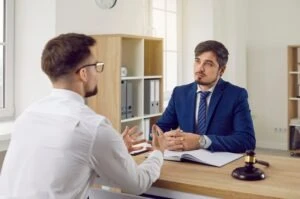
You can use video evidence in court, but its admissibility depends on more than just capturing the incident on tape. Its reliability and authenticity must be guaranteed. This requires a clear chain of custody, secure storage, and compliance with technical standards.
A Fort Lauderdale personal injury lawyer can investigate your case and gather any available video evidence to support it, such as traffic camera footage, surveillance footage from a premises, or other types of video evidence.
The Admissibility of Video Evidence
When presenting video evidence in court, your lawyer must first guarantee its admissibility. This involves validating that the video is authentic, reliable, and relevant to the case. Digital forensics plays a vital role in verifying the integrity of video evidence.
Experts use specialized tools and techniques to examine the video’s metadata, file format, and compression algorithms to detect any signs of tampering or alteration.
Authentication protocols are also vital in establishing the video’s authenticity. These protocols involve verifying the video’s origin, chain of custody, and handling procedures to confirm it hasn’t been compromised.
More people choose The Schiller Kessler Group because they know that we’re a cut above other personal injury law firms.

Authentication and Chain of Custody
Establishing a clear chain of custody is crucial in authenticating video evidence, as it verifies the video hasn’t been tampered with or altered in any way.
Your attorneys must demonstrate that the video has remained unchanged from the moment it was captured to the time it’s presented in court. To do this, a lawyer may take the following steps:
- Document every step: Keep a detailed record of everyone who has handled the video, including the date, time, and location.
- Conduct metadata analysis: Examine the video’s metadata to identify any inconsistencies or red flags.
- Use digital watermarks: Embed a digital watermark into the video to detect any tampering or alterations.
- Store the video securely: To prevent unauthorized access, store the video in a secure location, such as a locked cabinet or encrypted digital storage.
Requirements for Admitting Video Evidence
Before presenting your video footage in court, you must meet specific requirements that guarantee it is relevant, reliable, and authentic. The court needs assurance that the video has not been tampered with or altered in any way.
Your attorney will also need to provide documentation detailing the video’s origin, including when and where it was recorded, who recorded it, and how it’s been stored. By meeting these requirements, you can increase the chances of your video evidence being admitted in court.
Challenges to Video Evidence Admissibility
Even with proper preparation, challenges to admissibility can still arise with video evidence in court. Despite your best efforts, the opposing party may raise objections, questioning the authenticity or reliability of your video evidence.
Some common challenges to video evidence admissibility include:
- Lack of authentication: The opposing party may argue that the video evidence is not what it claims to be or was not properly authenticated.
- Video tampering: You may need to prove that the video evidence has not been altered or tampered with in any way.
- Digital alteration: The opposing party may claim that the video evidence has been digitally altered or enhanced to manipulate its content.
- Chain of custody: You may need to demonstrate a clear chain of custody to show that the video evidence has been properly handled and stored.
Your attorney will be prepared to address these challenges by providing clear documentation and expert testimony to support the admissibility of your video evidence.
Other Forms of Evidence a Lawyer Can Obtain and Present in Court
While video evidence can be a powerful tool in proving fault and establishing liability, it’s often just one piece of the puzzle. A skilled lawyer can gather and present a wide range of evidence to strengthen your case.
These additional forms of evidence can help paint a clear picture of what happened, support your claims, and counter any arguments made by the opposing party.
Witness Testimonies
Eyewitness accounts can provide valuable perspectives on how the accident occurred. Witnesses who were present at the scene may be able to describe the actions of the at-fault party, road conditions, or other key details that a video might not capture. A lawyer can interview witnesses, obtain sworn statements, and, if necessary, call them to testify in court.
Police Reports
Police reports are often considered a crucial piece of evidence in car accident cases. These reports typically include details about the accident, such as the officers’ observations, statements from involved parties, and any traffic citations issued.
A lawyer can use the report to support your version of events or highlight evidence of reckless or negligent behavior by the other driver.
Photographic Evidence
Photos taken at the scene of the accident can be instrumental in proving key facts. Images of the damage to vehicles, skid marks, road conditions, traffic signs, and injuries can all serve as compelling evidence.
A lawyer can use these photos to recreate the scene of the accident and demonstrate how it occurred.
Medical Records
Medical records are essential for documenting the extent of your injuries and the treatment you’ve received. They help establish the connection between the accident and your injuries, as well as the financial and physical impact on your life.
A lawyer can obtain these records and work with medical experts to explain the significance of your injuries to a judge or jury.
Expert Testimony
In some cases, a lawyer may call on expert witnesses to provide specialized knowledge that supports your case. Accident reconstruction experts, for example, can analyze the evidence to determine how the collision occurred, while medical experts can testify about the severity of your injuries and their long-term effects.
These experts can help clarify complex details and strengthen your argument.
Cell Phone Records
If distracted driving is suspected, a lawyer may obtain the at-fault party’s cell phone records to determine if they were texting, calling, or using their phone at the time of the accident. This evidence can demonstrate negligence and support your claim that the other driver was at fault.
We Can Determine if You Can Use Video Evidence in Court for Your Personal Injury Case
Our personal injury lawyers can determine if you can use video evidence in court in your particular case. We can do the leg work required to obtain any available video footage relevant to your case and use it to strengthen your claim.
To discuss your case, contact The Schiller Kessler Group for a free consultation.
Injured? Call The Aggressive Attorneys Today

